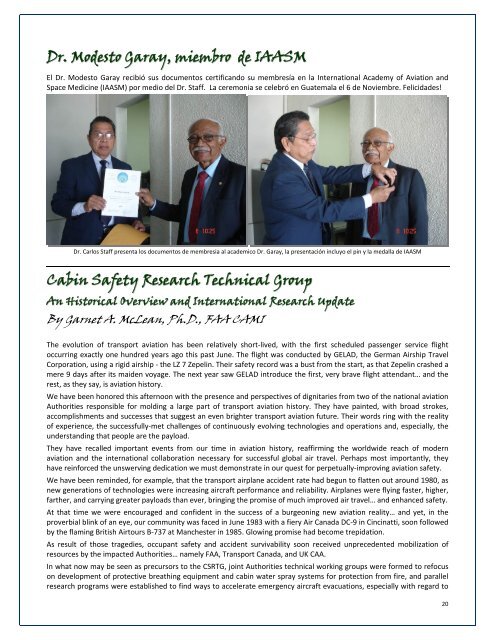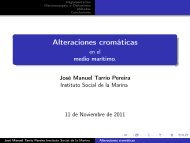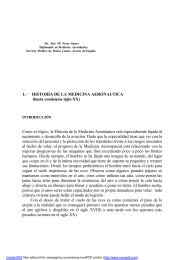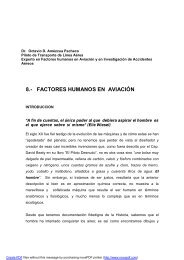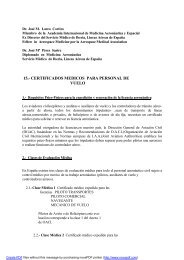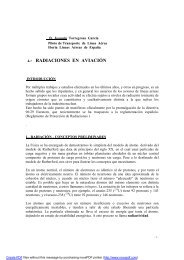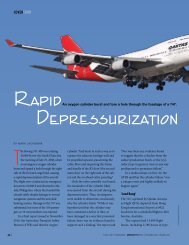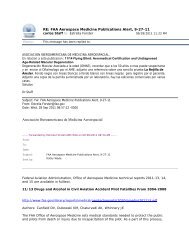AIMA Boletin Vol11 No2 (Diciembre/2010) - SEMA
AIMA Boletin Vol11 No2 (Diciembre/2010) - SEMA
AIMA Boletin Vol11 No2 (Diciembre/2010) - SEMA
You also want an ePaper? Increase the reach of your titles
YUMPU automatically turns print PDFs into web optimized ePapers that Google loves.
Dr. Modesto Garay, miembro de IAASM<br />
El Dr. Modesto Garay recibió sus documentos certificando su membresía en la International Academy of Aviation and<br />
Space Medicine (IAASM) por medio del Dr. Staff. La ceremonia se celebró en Guatemala el 6 de Noviembre. Felicidades!<br />
Dr. Carlos Staff presenta los documentos de membresia al academico Dr. Garay, la presentación incluyo el pin y la medalla de IAASM<br />
Cabin Safety Research Technical Group<br />
An Historical Overview and International Research Update<br />
By Garnet A. McLean, Ph.D., FAA CAMI<br />
The evolution of transport aviation has been relatively short‐lived, with the first scheduled passenger service flight<br />
occurring exactly one hundred years ago this past June. The flight was conducted by GELAD, the German Airship Travel<br />
Corporation, using a rigid airship ‐ the LZ 7 Zepelin. Their safety record was a bust from the start, as that Zepelin crashed a<br />
mere 9 days after its maiden voyage. The next year saw GELAD introduce the first, very brave flight attendant… and the<br />
rest, as they say, is aviation history.<br />
We have been honored this afternoon with the presence and perspectives of dignitaries from two of the national aviation<br />
Authorities responsible for molding a large part of transport aviation history. They have painted, with broad strokes,<br />
accomplishments and successes that suggest an even brighter transport aviation future. Their words ring with the reality<br />
of experience, the successfully‐met challenges of continuously evolving technologies and operations and, especially, the<br />
understanding that people are the payload.<br />
They have recalled important events from our time in aviation history, reaffirming the worldwide reach of modern<br />
aviation and the international collaboration necessary for successful global air travel. Perhaps most importantly, they<br />
have reinforced the unswerving dedication we must demonstrate in our quest for perpetually‐improving aviation safety.<br />
We have been reminded, for example, that the transport airplane accident rate had begun to flatten out around 1980, as<br />
new generations of technologies were increasing aircraft performance and reliability. Airplanes were flying faster, higher,<br />
farther, and carrying greater payloads than ever, bringing the promise of much improved air travel… and enhanced safety.<br />
At that time we were encouraged and confident in the success of a burgeoning new aviation reality… and yet, in the<br />
proverbial blink of an eye, our community was faced in June 1983 with a fiery Air Canada DC‐9 in Cincinatti, soon followed<br />
by the flaming British Airtours B‐737 at Manchester in 1985. Glowing promise had become trepidation.<br />
As result of those tragedies, occupant safety and accident survivability soon received unprecedented mobilization of<br />
resources by the impacted Authorities… namely FAA, Transport Canada, and UK CAA.<br />
In what now may be seen as precursors to the CSRTG, joint Authorities technical working groups were formed to refocus<br />
on development of protective breathing equipment and cabin water spray systems for protection from fire, and parallel<br />
research programs were established to find ways to accelerate emergency aircraft evacuations, especially with regard to<br />
20


